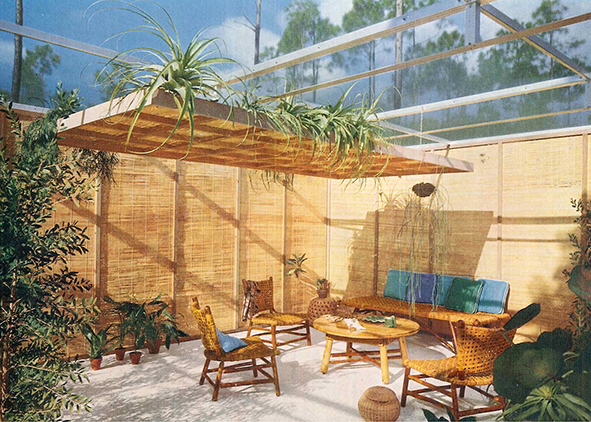Modular gardens by James C. Rose – A 1946 experiment for Ladies’ Home Journal
DOI:
https://doi.org/10.19229/2464-9309/1452023Keywords:
modern gardens, Japan, creative design, materiality, equityAbstract
The ‘module’ is a design tool that is profoundly intertwined with design concepts such as proportions and geometry as well as globalization, sustainability, and equity. Modular theories and paradigms are limited in the landscape architecture discourse. This paper examines the ‘module’ as a design tool in the early work and theory of American landscape architect James C. Rose (1913-1991). In 1946, the Ladies’ Home Journal commissioned a series of small gardens to be photographed and published in a special issue. Rose considered this challenge as a design-build exercise to develop modular garden prototypes for small American suburban lots. Modularity was reframed in Rose’s works and was developed in an artistic way that portrays close relationship to modern and Japanese ideas on this theme. An in-depth analysis and discussion of Rose’s modular concepts offers an opportunity to delve into novel ideas and processes that can prove insightful for high-quality humane landscape production.
Article info
Received: 06/10/2023; Revised: 29/10/2023; Accepted: 08/11/2023
Downloads
Article Metrics Graph
References
Arnheim, R. (1955), “A review of proportion”, in The Journal of Aesthetics and Art Criticism, vol. 14, issue 1, pp. 44-57. [Online] Available at: doi.org/10.2307/426640 [Accessed 19 October 2023].
Biancucci, A. (2017), “Terra e Cielo – Architetture di Melluso nel Paesaggio Mediterraneo | Earth and Sky – Architectures of Melluso in the Mediterranean Landscape”, in Agathón | International Journal of Architecture, Art and Design, vol. 2, pp. 173-180. [Online] Available at: doi.org/10.19229/2464-9309/2232017 [Accessed 2 November 2023].
Booth, N. (2012), “The Grid”, in Foundations of Landscape Architecture – Integrating Form and Space Using the Language of Site Design, John Wiley and Sons Inc., Hoboken (NJ), pp. 107-138. [Online] Available at: academia.edu/33145128/_Norman_Booth _Foundations_of_Landscape_Architectu_BookZZ_org_ [Accessed 2 November 2023].
Cardasis, D. (2017), James Rose – A Voice Offstage, The University of Georgia Press, Athens (Georgia).
Charitonidou, M. (2022), “Le Corbusier’s Ineffable Space and Synchronism – From Architecture as Clear Syntax to Architecture as Succession of Events”, in Arts, vol. 11, issue 12, pp. 1-29. [Online] Available at: doi.org/10.3390/arts11020048 [Accessed 19 October 2023].
Howett, C. (1994), “Modernism and American Landscape Architecture”, in Treib, M. (ed.), Modern Landscape Architecture – A Critical Review, MIT Press, Cambridge (MA), pp. 18-35.
Kuroishi, I. (2009), “Mathematics for/from Society – The Role of the Module in Modernizing Japanese Architectural Production”, in Nexus Network Journal, vol. 11, issue 2, pp. 201-216. [Online] Available at: doi.org/10.1007/s00004-007-0087-1 [Accessed 19 October 2023].
Liotta, S.-J. A. (2017), “Architettura e Natura in Giappone – Nishizawa, Kuma e Fujimoto | Architecture and Nature in Japan – Nishizawa, Kuma and Fujimoto”, in Agathón | International Journal of Architecture, Art and Design, vol. 2, pp. 165-172. Online] Available at: doi.org/10.19229/2464-9309/2222017 [Accessed 2 November 2023].
Pratt, R. (1963), Ladies’ Home Journal Book of Landscaping and Outdoor Living, Grosset & Dunlap Publishers, New York.
Rose, J. C. (1958), Creative Gardens, Reinhold Publishing Corporation, New York.
Rose, J. C. (1954), “A Contemporary American House – The Spatial Discipline”, in Progressive Architecture, issue 12, pp. 114-119. [Online] Available at: usmodernist.org/PA/PA-1954-12.pdf [Accessed 19 October 2023].
Rose, J. (1947a), “Modular Gardens”, in Progressive Architecture, vol. 28, issue 9, pp. 76-80. [Online] Available at: usmodernist.org/PA/PA-1947-09.pdf [Accessed 19 October 2023].
Rose, J. (1947b), “Modular Gardens – Part II”, in Progressive Architecture, vol. 29, issue 10, pp. 81-84. [Online] Available at: usmodernist.org/PA/PA-1947-10.pdf [Accessed 19 October 2023].
Russel, A. (2012), “Modularity – An Interdisciplinary History of An Ordering Concept”, in Information & Culture | A Journal of History, vol. 47, issue 3, pp. 257-287. [Online] Available at: jstor.org/stable/43737345 [Accessed 19 October 2023].
Sarro, A. (2017), “Architettura e Paesaggio nella Città Contemporanea | Architecture and Landscape in the Contemporary City”, in Agathón | International Journal of Architecture, Art and Design, vol. 2, pp. 141-148. [Online] Available at: doi.org/10.19229/2464-9309/2192017 [Accessed 2 November 2023].
Sendai, S. (2019), “The Conception of ‘Equipment’ by Charlotte Periand – Cross Over Between Le Corbusier and Japan”, in Journal of Asian Architecture and Building Engineering, vol. 18, issue 5, pp. 430-438. [Online] Available at: doi.org/10.1080/13467581.2019.1678473 [Accessed 19 October 2023].
Sposito, A. (2017), “Architettura e Natura | Architecture and Nature”, in Agathón | International Journal of Architecture, Art and Design, vol. 2, pp. 3-10. [Online] Available at: doi.org/10.19229/2464-9309/212017 [Accessed 19 October 2023].

Downloads
Published
How to Cite
Issue
Section
Categories
License
Copyright (c) 2023 Anna-Maria Visilia

This work is licensed under a Creative Commons Attribution 4.0 International License.
This Journal is published under Creative Commons Attribution Licence 4.0 (CC-BY).
License scheme | Legal code
This License allows anyone to:
Share: copy and redistribute the material in any medium or format.
Adapt: remix, transform, and build upon the material for any purpose, even commercially.
Under the following terms
Attribution: Users must give appropriate credit, provide a link to the license, and indicate if changes were made; users may do so in any reasonable manner, but not in any way that suggests the licensor endorses them or their use.
No additional restrictions: Users may not apply legal terms or technological measures that legally restrict others from doing anything the license permits.
Notices
Users do not have to comply with the license for elements of the material in the public domain or where your use is permitted by an applicable exception or limitation.
No warranties are given. The license may not give users all of the permissions necessary for their intended use. For example, other rights such as publicity, privacy, or moral rights may limit how you use the material.


















































































